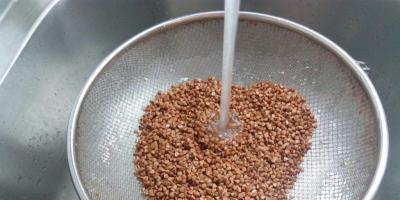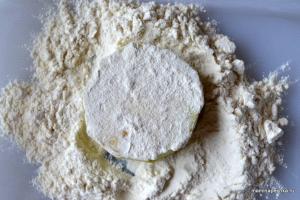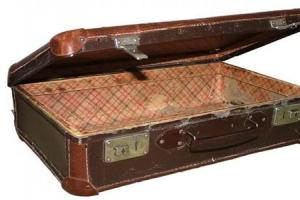There is still snow, but garden centers already have shelves with primrose pots. And who came up with the idea to name this extraordinary flower - common primrose?
Bright blue, purple and snow-white flowers can be purchased from March to May at almost any garden center. Or you can sow seeds and plant your own plants in the garden in the spring.
Primula translated from Latin as “first”: it blooms very early. And one of the first to bloom is the stemless or common primrose ( Primula acaulis, or R. vulgaris). It's small herbaceous plant with single flowers, most often white or yellow, less often pink, lilac or purple with an eye.
Often on a plant in bloom it is impossible to even see the leaves - they are completely covered by numerous flowers. The stemless primrose and its hybrids are easy to distinguish from other primroses - the flowers are solitary, not collected in an inflorescence, each on its own stem.
 The best way to get resistant primroses is to ask your neighbors and friends for clones that have been growing well for a long time. You can buy flowering specimens, then the species and variety will not be in doubt.
The best way to get resistant primroses is to ask your neighbors and friends for clones that have been growing well for a long time. You can buy flowering specimens, then the species and variety will not be in doubt.
In winter, primrose rhizomes are sometimes sold; they can be bought and stored briefly in sphagnum moss in the refrigerator, in the vegetable compartment. If they grow prematurely, plant them in pots and keep them cool, preferably on a loggia. In the room with high temperature and low air humidity, planted primroses will most likely die.
Seeds of terry primroses are available on sale. But if you look at the picture, and then at the living flower more closely, you discover that there are still five petals, but they have a wavy edge and they are half-open, the middle is not visible, so the flower seems double.
Truly double (multi-petaled, without stamens and pistil) flowers are sterile and can only be propagated vegetatively. Stemless primroses also have these.
New varieties and hybrids appear every year, and it is often quite difficult to understand what is sustainable and what is not. In general, resistant primrose clones are as close as possible to natural look by color and size of flowers. The flowers themselves are pastel hues, not blue and without large bracts (a collar of leaves immediately under the flower).
 Best time for planting - as soon as the snow melts, but with regular watering they can be divided and replanted at any time convenient for you. Primulas take root at low temperatures (planted in late summer - autumn, they often do not survive until spring).
Best time for planting - as soon as the snow melts, but with regular watering they can be divided and replanted at any time convenient for you. Primulas take root at low temperatures (planted in late summer - autumn, they often do not survive until spring).
Ideally, such primroses need partial shade with rich loamy soil, good nutrition (for abundant flowering), absence of both soaking and drying out. But they can also tolerate full sun, provided guaranteed watering is provided.
Primroses require almost no care. After the snow melts, clean them of dead leaves. Weed away aggressive weeds and water in hot and dry weather. Primroses respond well to mulching and fertilizing with complex mineral fertilizer.
During the flowering period and active growth primroses are fed with nitrogen or complete fertilizers, and at the end of summer - with phosphorus and potassium.
The species plants are very stable and can withstand any snowless winters. Poor wintering is usually typical for varieties that are not resistant or planted in a damp place. Blue and large-flowered primroses die first. There is no point in covering plants: they get wet more often than they freeze, and this is exactly what will happen under cover.
Stemless primroses are propagated by seeds and vegetatively. At favorable conditions Self-seeding occurs in the garden, but the easiest way is to divide them. Primroses grow well and even require periodic division.
The plant needs to be dug up, divided into separate rosettes with a knife and planted in a new place. The best time for this is the earliest spring after the snow has melted, but you can divide primroses both in bloom and before the onset of the summer heat.
Autumn division is possible, but undesirable: if a snowless winter occurs, poorly rooted plants may die. You can separate the rosettes without digging up the entire bush.
Old bushes become bare in the middle and rot due to excessive density. They should be maintained by regular (every 3-4 years) division with transplantation to a new location.
Interesting variety-series of stemless primrose
Arctic (Arctic) — large flowers white, yellow, red, blue and other colors. Very popular variety F1 Arctic Blue with bright blue flowers with a yellow eye.
Arizona (Arizona) - simple flowers of various colors with an eye.
Dakota (Dakota) - simple flowers of various colors (pink, purple, white, orange). Up to 15 cm high.
Glory Fantastique (Glory Fantastic) - flowers with a yellow center and a border of pink, blue, crimson and white flowers.
Hether (Hetor), a very interesting variety Heather Ville Apfelblute- a plant with a white-pink flower with an eye.
Paloma (Paloma) - double flowers of various colors (pink, white, red and bright yellow). Height 10-12 cm.
Rosanna (Rosanna) - large, double, rose-like flowers of various colors (white, yellow, pink, red).
Primula stemless in the garden
 Primroses make dense borders and colorful rugs. The array can be located either near the track or at some distance from it. For one group it is worth using primroses of the same color. This is easy to do if you divide one overgrown clump.
Primroses make dense borders and colorful rugs. The array can be located either near the track or at some distance from it. For one group it is worth using primroses of the same color. This is easy to do if you divide one overgrown clump.
Primulas can be easily combined with tall perennials that will protect them from the scorching sun in summer - peonies, phlox or even roses.
Even more suitable companions when planting primroses in partial shade. There are only two restrictions here: neighbors should not cover the primroses tightly with their leaves and should not be too aggressive.
Ferns, even large ones, simply planted at the proper distance, hostas, grasses, mountain weeds, hellebores - almost the entire shady assortment - go well with them. Very good at joint plantings small-bulbous.
Large-flowered, low-winter-hardy varieties of primroses are usually grown in pots. They can survive a winter or two in the garden, but in frosty weather they will be the first candidates to be killed.
And more often than not, the more beautiful the primrose, the more unstable it is. Nevertheless, at home it will definitely die, and when planted in the garden it will delight you much longer.
Primulas are sold in small plastic pots with soil consisting of peat mixed with fertilizer beads to make the plant bloom more abundantly. This substrate is good for a “bouquet”, but in order to provide the primrose long life, she needs to be transplanted.
Select the volume of the pot twice as large as the above-ground part. Plastic bag ready soil For indoor plants mix with the same volume of coarse sand. Shake off the old soil from the roots and plant the plant in a new pot without deepening the root collar.
Water with soft, settled water, being careful not to splash water on the leaves. If the soil has become very compacted and subsided, add it to the required level.
There is an opinion that the flowers of indoor plants caught in difficult conditions winter apartment from a bright greenhouse or a spacious flower shop, it is better to remove it. Look at the situation, but most often, if the plant is really having a hard time, it stops blooming.
The next stage is choosing a place in the house. It should be cool, with a temperature not much above zero, up to a maximum of +12...+15 °C.
Primrose also needs to be provided with bright lighting, protection from direct sunlight, and high humidity. Room dryness is disastrous for it, and spraying will not help the matter. It is better to put the pot in a greenhouse.
Sowing primrose for seedlings
 Plants from seeds collected in your garden do not retain varietal characteristics, but this is how you can get new interesting colors. Before sowing, store primrose seed pods at a temperature no higher than +5...+7°C.
Plants from seeds collected in your garden do not retain varietal characteristics, but this is how you can get new interesting colors. Before sowing, store primrose seed pods at a temperature no higher than +5...+7°C.
Before sowing, carefully shake out the seeds from the dried fruits over a saucer. Treat seeds collected in the garden to protect the seedlings from fungi. To do this, prepare a 0.5-1.0% solution of potassium permanganate. Place the seeds in the prepared potassium permanganate solution for 20 minutes. There is no need to process purchased seeds; just steam the soil.
Spread clean snow on the soil in a container and scatter the seeds - this way they will end up evenly and without embedding on the soil surface. The snow needs to be compacted after sowing.
Cover the container with a lid. Fresh seeds usually germinate after a short cooling, so the container with the seeds should be kept in the refrigerator or under snow for 2-4 weeks.
Crops that have undergone stratification can be placed on a bright window, shaded from direct sunlight. Optimal temperature for seedling development +16…+18°С. When two true leaves appear, the seedlings dive. To do this, carefully pry up the large nests without damaging the roots and place them on a saucer.
Divide the seedlings one by one and plant them in a box at 5 cm intervals or in individual pots. Pour in a thin stream of water. In the future, young plants need to be regularly watered and fed.
The grown seedlings in June after the end of the threat of frost in the same container can be buried in a semi-shaded place in the garden until the end of summer. On permanent place It is better to plant plants in the second half of August, when cool and rainy weather, at a distance of 25-30 cm from each other.

Olga Bondareva, Olga Petina
Primroses are flowers that will certainly become the pride of any garden. Growing a multi-colored carpet of these wonderful early flowers is much easier than you think. Read how to plant and care for primrose in this article.
– flowering plant, which will decorate any area, be it a garden or a small flower bed. Growing these delightful flowers will be successful if you know a few growing tricks primrose at home.
Primrose may bloom colorful flowers, which is the main advantage of the flower, because it’s so nice to watch the bright lawn. Most gardeners begin to grow a flower already at the end of winter from seeds.
If you have well-lit greenhouse, then the sowing date can be postponed to December. It is also advisable that the plant be planted in a greenhouse due to the fact that early planted on the windowsill the flower can grow very large.
On summer cottage you can sow primrose immediately after The snow will melt from the ground.
In order to sow a flower, a mini-greenhouse or plastic cups . Some housewives have also found a way out of the situation by using plastic containers for storing food.


To sow primrose, use flower soil. It can be purchased at any seed store or flower shop. The soil must contain components such as perlite and vermiculite.
Sowing seeds consists of the following stages:
- Pour the seeds onto a napkin and, after wetting a toothpick, carefully pick up the seed and put it in the ground. Before sowing, moisten the soil to prevent the seeds from drying out.
- Cover the seeds with film and store at room temperature
- The container with primrose should not be exposed to the sun, but the room where the flowers grow should be well lit
- When you see the first shoots, monitor the soil moisture
- If you covered the greenhouse with film, you can periodically remove it and ventilate the crops
- Make sure the ground is not too wet and the mature seedlings have not rotted, water the seedlings from a small watering can
After the primroses have grown, you can dive them or, if it’s already warm enough outside, plant flowers in open ground.
Video: Indoor primrose: planting and care
Growing primrose in the garden, in a greenhouse
The variety of primroses includes about 500 species, all this variety of varieties and hybrids represents a wide variety of colors and shades. The timing and flowering period also differ.
Primrose in the garden one of the first to bloom, it is because of this that the flower got its name - “primrose” with Latin language translated as "first, early." If you have a well-lit greenhouse with a temperature comfortable for sowing, you can use it and grow flowers there from winter.


Initially, you can use the method indicated above, and then, when the seedlings sprout, transplant them into a greenhouse. Or immediately sow primrose in a greenhouse. The first and most important condition for proper cultivation Temperature determines the temperature of flowers of this type in a greenhouse. Shouldn't be in the greenhouse below +16C. The growing technology looks like this:
- In the soil, water the rows approximately 5 cm depth
- Place the seeds in a bottle of water and poke a few holes in the lid.
- Water the rows from a bottle, so the seeds will be evenly distributed into the soil
- After this, gently sprinkle it lightly with soil.
After such planting, the seeds will already be sufficiently moistened and well will be accepted in a new place. To ensure that the seeds germinate well, make sure that the soil is constantly moist, but not wet.
Primula Rosanna, growing from seeds
IN flower shops On sale you can see a beautiful terry variety of primrose. This kind called Roseanne. In fact, this is not quite a double species (we will talk about that later), but thanks to the wavy edge, the flower is very similar to this variety.

 Primrose "Roseanne"
Primrose "Roseanne" Variety Rosanna Quite unpretentious, adapts well to both transplants and division. You can plant seeds as soon as the snow melts or in the fall, then after the cold weather you will already see first shoots. Primroses grow well in partial shade with moderate moisture, but even in the open sun and increased watering, the flowers will also delight you with bright greenery and beautiful blooms.
If you have already grown primrose, you can collect seeds in the fall and prepare for planting next year, or buy seeds and act in the following way:
- Store seeds until sowing at temperatures up to +7 C
- Before planting, treat the seeds with a special liquid, which you can purchase at a seed store. If you bought seeds and did not prepare them yourself, then no need to do this, since the manufacturer himself carries out this procedure.

 The variety "Rosanna" resembles small roses
The variety "Rosanna" resembles small roses Also It is important to remember that:
- After planting in the container, place the container with the seeds in the refrigerator for a month
- After this, transfer the seeds to a room at room temperature.
- When you see two leaves on Rosanna, you should pick the plant
- If frosts are no longer expected, then the container with the seedlings should be buried in the partial shade of the garden, and after a month you can plant them approximately at a distance 30 cm apart from each other
Primrose variety Rosanna blooms very beautifully, like flower carpet covers your lawn. Use these tips and enjoy lush beauty in your garden all summer long.
Primula aurica, growing from seeds
Primula auricula is also called auricular, there are about 20 different types of it. The plant is low-growing with succulent leaves and oval petals resembling bear ears.


This type can be plant in October, for the winter, and after the snow melts you can see the first shoots. Or in mid-March, then the seedlings will grow approximately In 2 weeks.
In order to get good seedlings after sowing seeds in the spring use these tips:
- Plant seeds in partial shade but with enough light
- This type of primrose grows in the mountains, so they tolerate stagnation of water well, but it is still advisable to provide the flower with good watering
- Plant the seeds in a container or plastic cups, and store the container at room temperature until germination.
- After the sockets appear 3-4 leaves primrose can be planted in open ground, in a permanent place
- Auricular primrose blooms in the second year after planting, therefore, unfortunately, in the first year you will not be able to admire its wonderful flowering

 Auricular primrose is one of the most common varieties
Auricular primrose is one of the most common varieties Ear primrose after 3 years life can be propagated by cuttings. Thus, over time you will be able to get a beautiful clearing of primroses on your site.
Primrose fine-toothed, growing from seeds
Primrose fine-toothed is a real decoration of the garden, as it has inflorescences in the form of large balls With small flowers. This variety blooms quite early - already in mid-April.


For good growth colors should be taken into account such nuances:
- It is best to grow fine-toothed primrose in partial shade in slightly acidic soil.
- When sowing, consider the distance - it should be about 30 cm, so that the leaves of the flower have enough space, but there is no free space
- You can sow fine-toothed primrose seeds immediately in open ground, after the snow has melted from the ground. This variety is quite resistant to frost and cold, so you don’t have to worry that the flowers will be disturbed by unstable spring weather
- When sowing in autumn, for a good wintering, cover the crops with a layer of fallen leaves
- When it has already grown from the seeds beautiful flower, it is better to tear off the lower leaves to exclude the possibility diseases of fungus and rot.
Fine-toothed primrose is great for decorating flower beds; it goes perfectly with daffodils, peonies, tulips, and also stands out brightly among lawn grass.
Primrose perennial, growing from seeds
Perennial primrose- this is a real find for a shady garden. Since it is quite unpretentious in care and blooms even in swampy places from the earliest spring. To grow this type of primrose, you should use with these recommendations:
- If you intend to grow a plant from seeds, then first you need to age the previously collected or purchased seeds 2 weeks in the refrigerator at a temperature no higher +6С

 Perennial primrose will become an indispensable resident of your garden.
Perennial primrose will become an indispensable resident of your garden. - Next, plant the seeds in flower soil and leave the container with flowers at a temperature +18С-+21С
- If the weather is already quite warm outside after 3-4 leaves have appeared on the shoots, you can plant flowers in open ground
- Prepare a shady place for the primrose, ensure regular watering of the transplanted flowers
- Primrose is enough rarely gets sick, but it is often attacked by slugs, so make sure that after watering there are no pests on the young leaves
Perennial primrose is easy to grow from seeds. The main thing is monitor soil moisture and repel pest attacks.
Terry primrose, growing from seeds
Terry primrose- an unusually beautiful, but also quite whimsical flower. This variety does not grow in all areas and soils. The plant does not grow in too sunny places, in dense earth and with insufficient watering.


One of the main tips for gardeners when growing this variety is mulching, which helps to avoid overdrying of the soil.
Propagate with seeds This variety is much more complex than the others. It is also worth considering that purchased double flowers are more expensive and come in bags. no more than 5 pieces. Be prepared for the fact that not all seeds will sprout. For sowing seeds terry primrose follow the given steps:
- Buy or collect primrose seeds in advance, it is advisable to sow twice - at the end of February and beginning of May
- The soil for sowing must be loose, the best option there will be a special flower soil
- Plant primrose deep 2 mm, compact and slightly moisten the soil


- The seeds will sprout no earlier than in 1.5 months, so don't worry if after 2 weeks, as they promise on the packaging, you will not see shoots
- Terry primrose grows slowly and for a long time, February planting will bloom by the end of autumn, and May planting only next year
- When appeared on sockets 3-4 leaves, you should pick the seedlings
- Through 1.5 months after the dive, you can plant flowers in a permanent place
During the period of growth and flowering do not forget to water the primrose, since the terry variety is very moisture-loving. To ensure continuous flowering, regularly delete wilted flowers . A year after sowing, you will see extraordinary beauty, for the sake of which it was worth paying so much attention to the whimsical flower.
Indoor primrose, growing from seeds
Primrose can grow not only in the garden, but also please the eye in the bedroom or kitchen. People consider tea with primrose flowers healing drink for calming, and primrose leaves replenish the body's needs in vitamin C.


But one of the negative nuances indoor primrose are allergic reactions. Many gardeners complain of a rash on their hands after caring for a plant. Therefore, if there are small children in the house, it is better to put a flower to a place inaccessible to them.
When growing indoor primrose from seeds use the instructions:
- Plant the seeds in June in moist soil to a depth of approximately 2 mm
- Fill the top with soil and press down lightly
- Cover the container with seeds with glass and place it on the windowsill on the shaded side.
- Make sure the soil is moist, but under no circumstances overwater the seeds; excess moisture will cause them to rot.
- When the first shoots appear, place the container in a bright place with diffused light
- If it has already appeared on the sockets 5-6 leaves, you can transplant the primrose into a permanent pot
- During flowering, primrose should be fertilized with a special complex fertilizer.
Indoor primrose, with proper care, blooms in the year of sowing. You can sow seeds at any time, the main thing is to provide the flower with room temperature, regular watering and you will soon be able to admire the gorgeous flowers.
Primrose stemless, growing from seeds
Primrose stemless from seeds very easy to grow. To save money, you can collect seeds from your own garden and thus propagate on your site floral carpet, such plants do not retain varietal characteristics, so new colors can be obtained from them.


Write down detailed instructions for growing stemless primrose from seeds:
- Before sowing, store primrose at a temperature up to +7C
- Before sowing, treat the seeds in a weak solution of potassium permanganate and pour onto a plate
- Pour flower soil into a container or other container and scatter the seeds to a depth 4-5 mm
- Gently pour soil on top of the seeds and compact lightly
- Use a small watering can or syringe to moisten the soil.
- Cover the container with film and place for a week in the refrigerator
- After stratification, leave the seeds to grow at room temperature
- When 2-3 leaves stemless primrose can be picked


Seedlings can be planted in open ground in mid-August. Then by next year the plant will have become sufficiently strong and will delight you with beautiful flowers.
There is information about primroses beautiful legend. They say that the Apostle Peter dropped the keys to Paradise from heaven, and when they landed on earth, in this place mature primrose. This beautiful legend once again confirms that primrose is flower of paradise, which will help create a heavenly atmosphere in your garden.
Terry primrose The talisman of spring is the bright and delicate terry primrose. The pinnacle of garden flower selection is considered to be an increase in the number of petals (doubleness) of the corolla. A clear confirmation of this is the terry primrose, which has transformed from modest yellow “keys” into a queen. spring garden. Miniature bouquets, reminiscent of border spray roses, fascinate with their grace and rich palette of colors. Pros and cons of terry hybrids Terry for primroses is an acquired characteristic; multi-petalled primroses are not found in nature. This direction of selection is especially developed in relation to three species - P. stemless, P. auricula and P. polyantha. Terry primroses are most often sold in flower shops as seeds and ready-made plants; they are the ones that amaze with their large flower sizes and deep and unusual shades. This group of primroses has both advantages and disadvantages. Let's talk about the pros first. Terry varieties have increased decorative properties. Multi-petal roses reach a diameter of 4–5 cm, and the flower cap is 10–15 cm. The dimensions of the plant itself are compact, even, the foliage retains an attractive appearance after flowering (especially in auricles). The flowering period for most hybrids is 2–3 months - it begins in April, continues throughout May, and extends into June. Many varieties at intensive care prone to re-blooming in September - October, this is a real find for the late autumn garden. They can be grown not only in the garden, but also room conditions. After autumn transfer to a pot, they bloom in February - March. They lend themselves well to early spring forcing from seeds and bloom in the first year of the growing season. But terry primroses also have disadvantages. They require more careful care, and to reach their full potential, fertile soil and regular watering. Winter hardiness varies in the range -23–25⁰ C, which is lower compared to conventional spring primroses. Varietal plantings For the winter, it is advisable to cover it or transfer it to a container. Although terry primroses are classified as perennials according to cultivation technology, they are rather young perennials and require frequent transplantation and bush rejuvenation. Some hybrids, such as Primlet F1, were originally bred as biennials. Terry varieties will not produce seeds, so they can only be propagated vegetatively. This is interesting! Great Britain is famous for its floral traditions. On April 19, the country celebrates Primrose Day, thus paying tribute to the prominent statesman Lord B. Disraeli, a great connoisseur and collector of these garden flowers. An indispensable attribute of the holiday is an exhibition of primroses. Popular series of terry primroses Despite the abundance of varieties, in middle lane Several variety series - groups represented by identical plants, but with different flower colors - have taken root and demonstrate good viability. The most popular terry primrose Rosanna F1. It forms dense compact bushes up to 15 cm high, crowned with a cap of multi-petaled flowers. The series includes 5 colors - red, pink, yellow, apricot and white. A true perennial, grows quickly, loves partial shade, moist and nutritious soil. American hydrid P. stemless Primlet F1 is exotically beautiful and unusual, but more difficult to grow in garden conditions. It was bred as a biennial; without a radical renewal of the bush, it quickly loses its decorative effect. They like to use it for forcing, since it is an extremely early plant and blooms in the first year of the growing season. Unlike Primlet, the double primrose of the Paloma F1 series can grow in one place for up to 7 years. The seeds are planted before winter or early spring; it blooms in the second year, lasting up to 50 days. Mixes of different colors are sold in stores. The terry primrose Rosie variety series is a new selection, characterized by early, long-lasting flowering, flower splendor, and versatility. It is equally good in an open flower bed, in a pot, or in an outdoor container. Note! P. auricularis or auricula has many terry varieties– Jupp, Xaver, Max, Suzanne, Crimson Glow. It is generally accepted that these are capricious plants, but multi-petalled auricula are much better adapted to open ground and cold climates than “eye-shaped” show specimens covered with a powdery coating. Agricultural technology for double flowers Terry primroses in key aspects of cultivation require the same agricultural technology as other garden primroses. Namely: they prefer partial shade; love light, well-fertilized soil; do not tolerate drought; need regular dividing of the bush, transplantation is easily tolerated; a taboo for the plant is waterlogging combined with cold. Most of the varietal primroses we grow easily overwinter and do not require special shelter. True, adding a nutrient substrate to the rhizome and a layer of fallen leaves won’t hurt. Features of growing from seeds Using primrose as an example Terry Rosanna Let's look at how to organize growing a flower from seeds. In the middle zone, the preferred method of sowing is not in open ground, but for seedlings. You need to start sowing primrose no later than February, since the plant requires stratification, takes a long time to germinate, and grows slowly. Step-by-step instruction as follows. Seeds are sown in a container with a light, damp substrate (peat mixture + vermiculite), without deepening it, sprinkled with water, covered with polyethylene and sent to a place with a cold but positive temperature (refrigerator, balcony, basement). Stratification time ranges from 10 days to 3–4 weeks. Next, the container is placed in the light, maintained at a temperature of 12, but not more than 18⁰ C, and waits for seedlings to appear. This process can take 25–30 days. The film is not removed immediately; the seedlings are gradually accustomed to open space and drier air. The substrate is kept moist, but not flooded. As soon as 2-3 true leaves appear, the seedlings are planted in separate cups (pots). They are planted in a permanent place after the onset of stable heat. Some gardeners recommend doing this only in the spring of next year, when a full-fledged plant has formed. Care technology Terry primrose is responsive to care. First of all, on the fertility of the substrate and watering. Not only the size of the corolla and the duration of flowering, but also the shade depends on this. On rich soils the color is deep and rich, on poor soils it is faded. The plant is fed for the first time in early spring, preferably with a solution. organic fertilizer. This feeding can be skipped if the bushes have been sprinkled with humus since the fall. Fertilize again by the end of summer. Full will do mineral fertilizer for flowers, for example, Fertik, Kemira. Maximum watering is given in May - June. During the dormant period (July - August), make sure that the soil does not dry out, but do not water it abundantly. Regular moistening is resumed when the plant begins to grow again - from the end of August. Every 3–4 years, and more often for some terry varieties, the bush is divided and replanted. When planting, make sure that the foliage of neighboring plants closes together and does not leave open space. Varietal primroses are recommended to be sprinkled with a dry nutrient mixture for the winter and covered with leaves.
Primrose terry Rosanna
Primroses are fairly easy to grow from seeds. You only need to know some of the features of primrose seed germination. The surface of the wet soil in the pot needs to be leveled and compacted. Scatter primrose seeds over the surface of the soil. Cover the crops with film or glass and place the pot with seeds for stratification - in the refrigerator for a month, periodically checking the soil moisture. At the same time, periodically ventilate the crops and shake off the condensation that forms on the film. After a month, remove the pot of primrose seeds from the refrigerator and place it in a warm, bright place, out of direct sunlight. Primrose seedlings will soon begin to appear. There is no need to rush and remove the film from the crops. It is necessary to ventilate the crops and not allow condensation to accumulate. When the small primroses get stronger, forming a rosette of several leaves, only then can you remove the film and transplant the plants to a permanent place - preferably in the shade or partial shade.
Terry stemless primroses are more difficult to propagate by seed than other species.
Terry primrose seeds are much more expensive, and there are only 5 pieces in a bag (some seeds may not germinate).
And yet, the bewitching beauty of long-blooming double primroses significantly covers all the moral and material costs of flower growers!
Stock up on the seeds of these wonderful plants now, in the fall, because I advise you to sow terry primroses as early as possible.
I sow terry stemless primroses twice: in winter and in spring (in February and in May).
Prepare loose, fertile soil for sowing terry primroses.
Bury the seeds 1-2 mm, after planting the seeds, compact the soil a little and gently moisten it without eroding the soil.
Please note that seedlings of terry primrose seeds appear after 1.5-2 months, and not as quickly as it is written on the purchased bag of seeds.
Terry primrose seedlings develop very slowly, seedlings grow for a long time. If you plant the seeds of terry primroses in February, then some stronger plants will bloom only in the autumn of the same year, and the rest of the seedlings will bloom only next year. Primrose seeds sown in May will sprout faster than those sown in February, but these primroses will bloom only next year.
These features of the development of terry primroses should be taken into account - patiently wait for germination and carefully care for the seedlings.
I pick up terry primrose seedlings according to a 15x15cm pattern, and plant the grown bushes in a permanent place in the garden.
In a year, the plant grown from seeds will have a marketable appearance and all the extraordinary beauty that breeders have given to terry stemless primroses.
A primrose bush with double flowers looks like an elegant, sophisticated bouquet closely surrounded by leaves. This plant is especially desirable in the late autumn garden.
To learn how to grow primrose from seeds, you must initially remember all the first and main stages of germination. Let them lie on a light windowsill for one or two days, then place them on the surface of slightly moist soil, wrap them in a plastic bag and place them in the refrigerator. If long time If you can’t germinate, place the seeds in the freezer for a couple of days at a temperature of almost minus ten degrees. Also, do not forget about moistening the soil in the bag, therefore, you need to look inside in time. After about ten days, the first shoots should appear. You shouldn’t worry too much if not all of them germinate at once (sometimes the seeds are hollow or just have a slightly delayed effect). After about 2 - 3 weeks, our seedlings can already be placed on the windowsill, but not under direct Sun rays(to the shaded part). When the very first two leaves appear, the plants should be pruned.
Next, the seedlings need to be gradually accustomed to open air. To do this, open the bag slightly in the shade; after another ten days, the polyethylene can be completely removed. To avoid direct sunlight, it is better to place the seedlings in a cool place on the eastern side of the room. After this, it should be watered a little in small doses (you can use a pipette or a spoon), and just a little bit of a special mixture bought in a store should be poured under the small stem. You should feed no more than once a week, also adding fertilizer in small doses. If early warming has already arrived, then you should take care of the correct location of the sprouts: during the day you can take them out to the balcony and leave them inside at night.
Our seedlings should be replanted only after the threat of frost has completely disappeared into specially prepared soil.
Seed germination rate may decrease after harvesting. Winter storage at room temperature will reduce the likelihood of germination by 60%. If you store them for less than a month, the seeds will divide according to their germination energy, and this will lead to large expenses. That is why it is worth sowing them in the ground after harvesting.
In February, sowing is carried out in a heated greenhouse. All grow well on a substrate of rotted litter, sand and turf. Seeds should be sown on the surface at a distance of 1 cm from each other. During germination, the temperature should be 17 degrees.
If sowing is done in the fall, the seeds will begin to grow in the 4th month. Primrose and primrose seeds can grow in daylight, while primrose seeds can grow in complete darkness.
Picking of seedlings is carried out in the phase of leaf appearance. If weather conditions are suitable, sowing can be done immediately. plan very carefully - you need to leave space between the rosettes of leaves.
Seedlings are germinated at the beginning of the growing season. For the winter they are covered with leaves. We wrote about how to prepare primrose for winter, and from here you will learn how to care for the plant in the fall.
Important! Primrose blooms are expected in the third year of life. IN harsh winters young bushes freeze or damp out. To save them, you need to update the insurance fund every week.
Read more about methods of propagating primrose and other features of growing a flower.
Soil and fertilizers
The soil for such a crop should be light, breathable, and with good drainage. A good solution would be to choose clay soil, however, you need to make sure that it is not heavy. The acidity should be weak or neutral.
Feeding is done once every 2 weeks, adding liquid fertilizer . Since the plant is very sensitive to the salt content in the soil, the fertilizer is diluted twice as much as indicated by the manufacturer.
Watering and humidity
The requirements for watering indoor primrose are similar to those that apply to plants grown in open ground. The soil in which the flower is grown must be moist and loose. It is important to especially carefully monitor the condition of the soil during flowering. Excess or lack of water has a bad effect on the duration of this process. When flowering ends, the amount of watering should be reduced. Do not allow the soil to dry out excessively.
The water requirements for watering primrose are as follows::
- It must be defended.
- You can use melted water or rainwater. Some plant growers use this option and are satisfied with the results. It is important to bring the watering temperature to room temperature.
- You should not use tap liquid, and if there is no other choice, it is better to boil it.
- You can water with distilled water.
Flowering occurs in early spring. It is important to create an optimal humidity level for the plant:
- Install a humidifier in the room. The grower will need to adhere to the regime and the humidity level will be at the required level.
- Maintain Humidity Levels simple method– Place a saucer of water next to the plant or place a damp cloth over the battery.
- You can place the pot on a pallet, and place expanded clay, moss and sand in the container. You will only need to water it periodically to maintain the required level humidity.
Temperature
Pests and possible diseases
Primrose is a hardy plant, but it can also be affected by diseases. Among the most common are the following:
- Powdery mildew. Yellow or brown spots appear on the top of the leaves. It resembles fungal spores. The development of the disease occurs at high humidity and moderate temperature. The infection persists in the affected areas.
- Gray rot. Affected areas are flowers, peduncles or leaves. They may become covered with a fluffy coating. The disease makes itself felt in cold weather. The infection can be spread by rainwater or ants.
Conclusion
In conclusion, it is worth noting that growing primrose from seeds is The best decision for experienced gardeners. This beautiful flower will delight the eye for many years. Now you know everything about primrose, including when to sow it.








